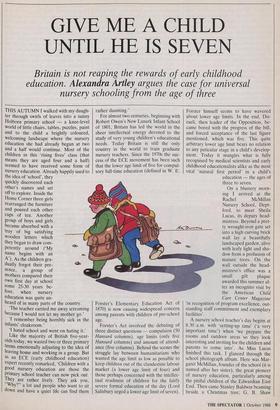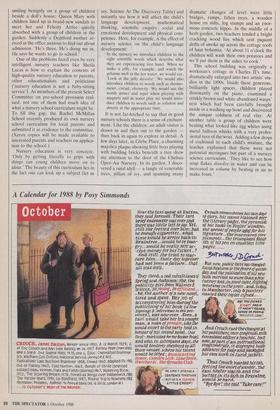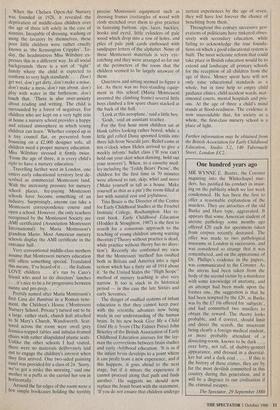GIVE ME A CHILD UNTIL HE IS SEVEN
Britain is not reaping the rewards of early childhood nursery schooling from the age of three
`The teacher carried me away screaming because I would not let my mother go.'
'I remember being horribly sick in the infants' cloakroom.'
`I hated school and went on hating it.' Like the majority of British five-year- olds today, we wasted two or three primary terms emotionally adjusting to the idea of leaving home and working in a group. But as an ECE (early childhood education) expert recently remarked, 'Children with a good nursery education are those the primary school teacher can now pick out. They are rather lively. They ask you, 'Why?" a lot and people who want to sit down and have a quiet life can find them
rather daunting.'
For almost two centuries, beginning with Robert Owen's New Lanark Infant School of 1801, Britain has led the world in the sheer intellectual energy devoted to the study of very young children's educational needs. Today Britain is still the only country in the world to train graduate nursery teachers. Since the 1970s the suc- cess of the ECE movement has been such that the lower age limit of five for compul- sory full-time education (defined in W. E.
Forster's Elementary Education Act of 1870) is now causing widespread concern among parents with children of pre-school age. Forster's Act involved the debating of three distinct questions — compulsion (50 Hansard columns), age limits (only five Hansard columns) and amount of attend- ance (five columns). Behind the scenes the struggle lay between humanitarians who wanted the age limit as low as possible to keep children out of the clandestine labour market (a lower age limit of four) and those perhaps concerned with the intellec- tual readiness of children for the fairly severe formal education of the day (Lord Salisbury urged a lower age limit of seven). Forster himself seems to have wavered about lower age limits. In the end, Dis- raeli, then leader of the Opposition, be- came bored with the progress of the bill, and forced acceptance of the last figure mentioned, which was five. This quite arbitrary lower age limit bears no relation to any paticular stage in a child's develop- ment. Today it mangles what is fully recognised by medical scientists and early childhood educationalists alike as the most vital 'natural first period' in a child's education — the ages of three to seven.
On a blustery morn- ing I arrived at the Rachel McMillan Nursery School, Dept- ford, to meet Sheila Lucas, its deputy head- mistress. Beyond a pret- ty wrought-iron gate set into a high curving brick wall lay a beautifully landscaped garden, alive with leafy light and sha- dow from a profusion of mature trees. On the wall outside the head- mistress's office was a A nursery school teacher's day begins at 8.30 a.m. with 'setting-up time' Ca very important time') when 'we prepare the rooms and outdoor areas so they look interesting and inviting for the children and parents to come into'. As Miss Lucas finished this task, I glanced through the school photograph album. Here was Mar- garet McMillan, founder of the school (it is named after her sister), the great pioneer of nursery education, particularly among the pitiful children of the Edwardian East End. Then came Stanley Baldwin beaming beside a Christmas tree; G. B. Shaw smiling benignly on a group of children beside a doll's house; Queen Mary with children lined up in brand-new sandals to meet her and Felicity Attlee quietly absorbed with a group of children in the garden. Suddenly a Deptford mother ar- rived in the office anxious to find out about admission. 'He's three. He's doing me in. He says he wants to go to school.'
One of the problems faced even by very intelligent nursery teachers like Sheila Lucas is how to explain the contents of high-quality nursery education to parents, other educationalists and politicians ('nursery education is not a baby-sitting service'). As members of the present Select Committee on pre-school provision real- ised, not one of them had much idea of what a nursery school curriculum might be. To fill this gap, the Rachel McMillan School recently produced its own nursery school curriculum for local parents and submitted it as evidence to the committee. (Xerox copies will be made available to interested parents and teachers on applica- tion to the school.)
Nursery education is very concrete. `Only by getting literally to grips with things can young children move on to ideas.' The beauty of this curriculum lies in the fact one can look up a subject (let us
say, Science At The Discovery Table) and instantly see how it will affect the child's language development, mathematical thinking, scientific enquiry, social and emotional development and physical com- petence. Here, for example, is the effect of nursery science on the child's language development:
In the nursery we introduce children to the right scientific words which describe what they are experiencing first hand. When we make a jelly, for example, and watch the gelatine melt in the hot water, we would say, 'Look at the jelly dissolve.' We would also introduce children to words such as thermo- meter, circuit, electricity. We would use the words attract and repel when playing with magnets and in water play we would intro- duce children to words such as solution and density at the appropriate time.
It is not far-fetched to say that in good nursery schools there is a sense of enchant- ment. Like the children, an adult visitor is drawn in and then out to the garden then back in again to explore in detail. A few days later, in Glebe Place, a charming majolica plaque showing little boys playing with building bricks beneath a tree drew my attention to the door of the Chelsea Open-Air Nursery. In its garden, I disco- vered a rural idyll — a tangle of venerable trees, pillars of ivy, and spanning many dramatic changes of level- were little bridges, ramps, fallen trees, a wooden house on stilts, log stumps and an enor- mous concrete hippo. In the middle of a herb garden, two teachers tended a bright crackling wood fire which sent piquant drifts of smoke up across the cottage roofs of haut bohemia. 'At about 11 o'clock the children will wash their own potatoes and we'll put them in the ashes to cook.'
This school building was originally a workman's cottage in Charles ll's time, dramatically enlarged into two artists' stu- dios in the 1890s. Inside these generous, brilliantly light spaces, children played dissonantly on the piano, examined a crinkly brown and white abandoned wasps' nest which had been carefully brought inside in a washing-up bowl and discovered the unique coldness of real clay. At another table a group of children were heating what looked like egg whites using metal balloon whisks with a very profes- sional turn of the'wrist. Adding a few drops of cochineal to each child's mixture, the teacher explained that these were not potential meringues but part of a nursery science curriculum. 'They like to see how soap flakes dissolve in water and can be increased in volume by beating in air to make foam.' When the Chelsea Open-Air Nursery was, founded in . 1928, it revealed the deprivation of middle-class children over the age of three left solely in the care of nannies. Incapable of dressing, washing or using the lavatory by themselves, these poor little children were rather cruelly known as 'the Kensington Cripples'. To- day, the headmistress Miss Wiltshire ex- presses this in a different way. In all social backgrounds 'there is a sort of "tight" family where the child is expected to conform to very high standards' . . . Don't get wet, don't get dirty, don't make a noise, don't make a mess, don't run about, don't play with water in the bathroom, don't touch that. 'There is also over-anxiety about reading and writing. The child is surrounded by a forest of negatives. For children who are kept on a very tight rein at home a nursery school provides a happy and relaxed atmosphere in which young children can learn.' Whether cooped up in a tiny council flat, or prevented from bouncing on a £2,000 designer sofa, all children need a proper nursery education. Miss Wiltshire stressed it firmly twice. 'From the age of three, it is every child's right to have a nursery education.'
Travelling further west in London, one enters early educational territory best de- scribed as commercial Montessori land. With the increasing pressure for nursery school places, fee-paying Montessori schools have become something of an industry. Surprisingly, anyone can take a Montessori correspondence course and open a school. However, the only teachers recognised by the Montessori Society are AMI certificated (Association Montessori International) by Maria Montessori's grandson Mario. Most American nursery schools display the AMI certificate in the entrance hall.
Very conventional middle-class mothers assume that Montessori nursery education still offers something special. Translated this means, 'I've heard of it . . . the Italians LOVE children . . . it's run by Caro's friend who used to do directors' lunches
• . . it's nice to be a bit progressive between nanny and pre-prep. . . Prettily named after Maria Montessori's first Casa dei Bambini in a Roman tene- ment, the Children's House ('Montessori Nursery School. Private') turned out to be a large, rather stark, church hall attached to St Mary's Church, Wandsworth. Scat- tered across the room were small grey formica-topped tables and tubular-framed chairs with rather dilapidated plastic seats. Unlike the other schools I had visited, there were no materials deliberately laid out to engage the children's interest when they first arrived. One two-sided painting easel was provided for a class of 24. 'Sorry, we've got a strike this morning,' said one mother in a puffa as she carried her son in horizontally.
Around the far edges of the room were a few simple bookcases holding the terribly precise Montessori equipment such as dressing frames (rectangles of wood with cloth stretched over them to give practice in fastening buttons, zips, laces, buckles, hooks and eyes), little cylinders of pale wood which drop into a row of holes, and piles of pale pink cards embosSed with sandpaper letters of the alphabet. None of these Montessori materials is very eye- catching and they were arranged so far out at the perimeters of the room that the children seemed to be largely unaware of them.
Quietness and sitting seemed to figure a lot. As there was no free-standing equip- ment in this school (Maria Montessori invented the climbing frame) several little boys climbed a few spare chairs stacked at the back of the hall.
'Look at this aeroplane,' said a little boy. 'Gosh,' said an assistant teacher.
For the first hour most children sat at blank tables looking rather bored, while a little girl called Daisy spooned lentils into three lids from Nescafe jars. Relief came at ten o'clock when Helen arrived to give a weekly infants' ballet class ('If you can't hold out your skirt when dancing, hold out your trousers'). When, to a cassette med- ley including the 'Teddy Bears' Picnic', the children for the first time in 70 minutes were allowed to run, skip, whirl and move (`Make yourself as tall as a house. Make yourself as thin as a pin') the room filled at last with natural zest and joyfulnesS. Tina Bruce is the Director of the Centre for Early Childhood Studies at the Froebel Institute College, Roehampton. Her re- cent book, Early Childhood Education (Hodder & Stoughton, 1987) is the first to search for a consensus approach to the teaching of yOung children among warring theorists (`Theory without practice is dead, while practice without theory has no direc- tion'). Recently she confirmed my view that the Montessori 'method' has ossified both in Britain and America into a rigid system which has a fusty air of 1914 about it. 'In the United States the "High Scope" method of nursery teaching is also very narrow. It too is stuck in its historical period — in this case the late Sixties and early Seventies.'
The danger of ossified systemS of infant
education is that they cannot now pace with the scientific advances now being made in our understanding of the human brain. In his new book Give Me a Child Until He is seven (The Falmer Press) John Brierley of the British Association of Early Childhood Education assesses for the lay- man the connections between brain studies and early childhood education. 'It is as if the infant brain develops to a point where it can profit froin a new experience, and if this happens, it goes ahead to the next stage, but if it misses the experience it cannot proceed along that path and finds another.' He suggests we should now replace the Jesuit boast with the statement, 'If you do not ensure that children undergo
certain experiences by the age of seven, they will have lost forever the chance of benefiting from them.' Throughout this century successive gen- erations of politicians have tinkered obses, sively with secondary education, while failing to acknoWledge the true founda- tionS on which a good educational system is built. The most welcome reform that could take place in British education would he to extend and landscape all primary schools for the reception of all children from the age of three. Money spent here will not only raise educational standards as a whole, but in time help to empty child guidance clinics, child accident wards, mat- rimonial courts, mental hospitals and pris- Ons. At the age of three a child's mind stands at flood-readiness. The evidence is now unavoidable that, for society as a whole, the first-class nursery school is a place of light.
Further information may be obtained from the British Association for Early Childhood Education, Studio 3:2, 140 Tabernacle Street, London EC2.




































































 Previous page
Previous page